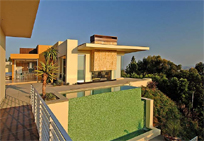Custom Pools or Aquatic Art?
By Paolo Benedetti
 Almost every advertisement for watershapes I've ever seen in a newspaper or the Yellow Pages says something about "custom" this or "custom" that. It always leads me to wonder how to differentiate between the "custom," "high-end" and "luxury" pools others devise and the "architectural pools" or, better yet, the "aquatic art" I strive to create.
Almost every advertisement for watershapes I've ever seen in a newspaper or the Yellow Pages says something about "custom" this or "custom" that. It always leads me to wonder how to differentiate between the "custom," "high-end" and "luxury" pools others devise and the "architectural pools" or, better yet, the "aquatic art" I strive to create.
I prefer the last two terms because custom, high-end and luxury have been so abused for so long that they're basically meaningless. It just means that the client visited the buffet, piled some things that were offered onto a plate ("Take it or leave it!") and paid the cashier on the way out. This is an eatery where not much is offered by way of service, innovation, ingredients or preparation; worse, it's a place where self-proclaimed master chefs do little more than ask clients to pay premium prices for mediocre meals.
To my way of thinking, clients want and deserve more. In place of a process based on cash extraction, they want a designer who approaches the project from the perspective of an aquatic artist. They want that designer to get inside their heads, find out what motivates them, discover their interests and help them define how the setting will be used. Then the designer steps back, investigates the site and its architecture (whether the home already exists or has yet to be built) and charts a course based on the characteristics of the setting and the scope of the clients' needs and desires.
Ready to Perform
The aquatic artist, armed with an education that includes knowledge of world history, art history, materials science and construction techniques as well as a background that includes skills in construction, product sourcing and project management, then offers the clients an assortment of concepts that are unique to the setting and their personalities. What results is a set of ideas and methodologies that have not been combined or used before - a unique response to a very specific set of circumstances.
As I've mentioned in previous articles in this newsletter, not everyone is cut out to be an aquatic artist. Often, an architect or landscape architect will do the layout of an aquatic environment, and the result will on some level be detached from the rest of the work rather than fully integrated. What is needed in these cases is consultation with a watershaping specialist who can ease a path through all of the architectural, structural, materials, control and visual-integration issues.
This does not mean that the aquatic artist always has to be inventing something new. Rather, it means that he or she is capable of approaching things with fresh, open eyes and knows how to adapt elements encountered in a lifetime of experience, travel and close observation - and then, of course, how to apply them to different scenarios.
I have taken small details that I have seen in my travels, for example, and enlarged them to a scale a hundred times larger than the original application - and often use them for entirely different purposes than the original. It's a frame of mind that allows me to think about how things I see can be tweaked, modified or rescaled for similar or different purposes.
Risks and Rewards
Of course, working as an aquatic artist is also about finding clients who are willing to be engaged by the process, enjoy thinking outside the box and are willing to go first when it comes to application of unique or individualized details. At times, this means they must be willing to finance the R&D - by which I mean Rework & Demolition - should an element not function exactly as intended or desired.
In compensation for this risk, they are rewarded with bragging rights. Better yet, I've worked with clients who, in seeking to reduce the risk by commissioning mock-ups or scale models to prove out a concept, get involved in a process that leads to further tweaking and innovation and even grander bragging rights.
The upshot of all of this is that, when I meet prospective clients, I spend time up front teaching them as much as I can about the marketplace they're entering and equipping them with information they need to sort out possibilities and make fair comparisons. In a world in which everyone calls himself or herself a "custom pool builder," "luxury pool designer" or "high-end designer/builder," I ask, "isn't an aquatic artist what you're really after?"
In that context, the answer oftentimes is a warm and welcoming yes.
